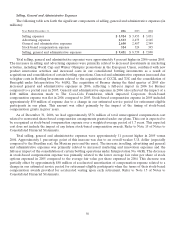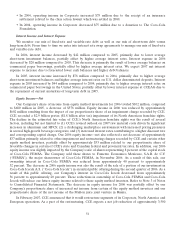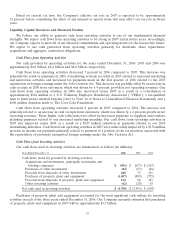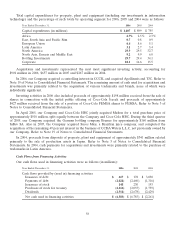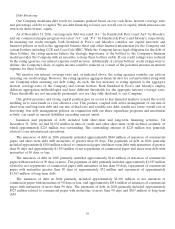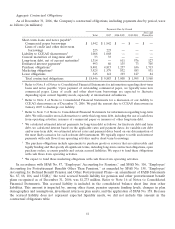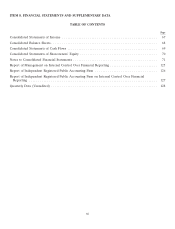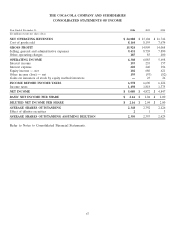Coca Cola 2006 Annual Report Download - page 61
Download and view the complete annual report
Please find page 61 of the 2006 Coca Cola annual report below. You can navigate through the pages in the report by either clicking on the pages listed below, or by using the keyword search tool below to find specific information within the annual report.Debt Financing
Our Company maintains debt levels we consider prudent based on our cash flows, interest coverage ratio
and percentage of debt to capital. We use debt financing to lower our overall cost of capital, which increases our
return on shareowners’ equity.
As of December 31, 2006, our long-term debt was rated ‘‘A+’’ by Standard & Poor’s and ‘‘Aa3’’ by Moody’s,
and our commercial paper program was rated ‘‘A-1’’ and ‘‘P-1’’ by Standard & Poor’s and Moody’s, respectively.
In assessing our credit strength, both Standard & Poor’s and Moody’s consider our capital structure and
financial policies as well as the aggregated balance sheet and other financial information for the Company and
certain bottlers, including CCE and Coca-Cola HBC. While the Company has no legal obligation for the debt of
these bottlers, the rating agencies believe the strategic importance of the bottlers to the Company’s business
model provides the Company with an incentive to keep these bottlers viable. If our credit ratings were reduced
by the rating agencies, our interest expense could increase. Additionally, if certain bottlers’ credit ratings were to
decline, the Company’s share of equity income could be reduced as a result of the potential increase in interest
expense for these bottlers.
We monitor our interest coverage ratio and, as indicated above, the rating agencies consider our ratio in
assessing our credit ratings. However, the rating agencies aggregate financial data for certain bottlers along with
our Company when assessing our debt rating. As such, the key measure to rating agencies is the aggregate
interest coverage ratio of the Company and certain bottlers. Both Standard & Poor’s and Moody’s employ
different aggregation methodologies and have different thresholds for the aggregate interest coverage ratio.
These thresholds are not necessarily permanent, nor are they fully disclosed to our Company.
Our global presence and strong capital position give us access to key financial markets around the world,
enabling us to raise funds at a low effective cost. This posture, coupled with active management of our mix of
short-term and long-term debt and our mix of fixed-rate and variable-rate debt, results in a lower overall cost of
borrowing. Our debt management policies, in conjunction with our share repurchase programs and investment
activity, can result in current liabilities exceeding current assets.
Issuances and payments of debt included both short-term and long-term financing activities. On
December 31, 2006, we had $1,952 million in lines of credit and other short-term credit facilities available, of
which approximately $225 million was outstanding. The outstanding amount of $225 million was primarily
related to our international operations.
The issuances of debt in 2006 primarily included approximately $484 million of issuances of commercial
paper and short-term debt with maturities of greater than 90 days. The payments of debt in 2006 primarily
included approximately $580 million related to commercial paper and short-term debt with maturities of greater
than 90 days and approximately $1,383 million of net repayments of commercial paper and short-term debt with
maturities of 90 days or less.
The issuances of debt in 2005 primarily included approximately $144 million of issuances of commercial
paper with maturities of 90 days or more. The payments of debt primarily included approximately $1,037 million
related to net repayments of commercial paper with maturities of less than 90 days, repayments of commercial
paper with maturities greater than 90 days of approximately $32 million and repayment of approximately
$1,363 million of long-term debt.
The issuances of debt in 2004 primarily included approximately $2,109 million of net issuances of
commercial paper with maturities of 90 days or less, and approximately $818 million of issuances of commercial
paper with maturities of more than 90 days. The payments of debt in 2004 primarily included approximately
$927 million related to commercial paper with maturities of more than 90 days and $367 million of long-term
debt.
59



